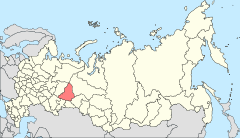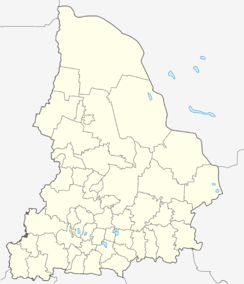- Serov (town)
-
For other uses, see Serov (disambiguation).
Serov (English)
Серов (Russian)- Town[citation needed] - 
Church of the Annunciation
Location of Sverdlovsk Oblast in RussiaCoordinates: 59°36′N 60°34′E / 59.6°N 60.567°ECoordinates: 59°36′N 60°34′E / 59.6°N 60.567°E Coat of arms Flag Administrative status Country Russia Federal subject Sverdlovsk Oblast Municipal status Mayor[citation needed] Vladimir Anisimov[citation needed] Statistics Area 438 km2 (169 sq mi)[citation needed] Population (2010 Census,
preliminary)99,381 inhabitants[1] - Rank in 2010 168th Population (2002 Census) 99,804 inhabitants[2] - Rank in 2002 167th Density 227 /km2 (590 /sq mi)[3] Time zone YEKST (UTC+06:00)[4] Founded 1894[citation needed] Postal code(s) 624XXX[citation needed] Dialing code(s) +7 34385[citation needed] Official website Serov (Russian: Серо́в) is a mining and commercial town in Sverdlovsk Oblast, Russia, located on the eastern foothills of the Ural Mountains, on the left bank of the Kakva River, a tributary of the Sosva River, about 350 kilometers (220 mi) north of Yekaterinburg. It serves as the administrative center of Serovsky District, although it is not administratively a part of it. Population: 99,381 (2010 Census preliminary results);[1] 99,804 (2002 Census);[2] 104,158 (1989 Census).[5]
Contents
Climate
The climate is continental, with temperate summers and cold snowy winters.
History
Archeological evidence suggests that the Serov area was populated as early as 1000 BCE by the Mansi or their ancestors. In the early days of Russian colonization of Siberia there were only a few minor villages in the area. The situation changed in 1893, when the chief manager of Bogoslovsk Mining District, Alexander Andreyevich Auerbach, proposed a construction of a cast iron and rail plant on Kakva River near the end of an existing railroad. This year the construction of a workers town began. The town was named Nadezhdinsk after Nadezhda Mikhaylovna Polovtsova, the owner of Bogoslovsk Mining District. The first steel and rails in Nadezhdinsk were produced in 1896. The town was an important supplier of rails for Trans-Siberian Railway. Dmitri Mendeleev, who visited Nadezhdinsk, was pleasantly surprised by the progressive technology used at the plant. The first school in Nadezhdinsk opened in December 1895, the first power plant (415 kW)—in 1907.
Nadezhdinsk was touched by the Russian Revolution of 1905, with the turmoil continuing through 1908. At the beginning of the World War I Nadezhdinsk industry was reshaped to meet the demands of the military. Klein Brothers machine-building factory was relocated to Nadezhdinsk from Riga in 1917. The growing demand for workforce was met by hiring workers from China and Korea, as well as prisoners of war (POWs). There were 1,266 Chinese and Koreans, and 3,329 POWs in Nadezhdinsk in 1917.
On October 27, 1917, two days after the October Revolution in Petrograd, the power in the town was bloodlessly transferred to the Worker's Soviet. On December 18, 1917, Bogoslovsk Mining District, including the Nadezhdinsk plants, was nationalized. In October 1918, the army of the Provisional Government of Siberia, which opposed the Soviets in the Russian Civil War, occupied Nadezhdinsk. On November 20, 1918, two days after admiral Kolchak become the head of the White government of Siberia, the "whites" in Nadezhdinsk executed 23 of their "red" opponents. On July 19, 1919, Red partisans, supporting the Soviets, took the town back. The town was devastated after the Civil War. None of the factories were working and many engineers left the area.
The Soviet government put a lot of efforts to restore the town life and economy. By the end of 1925, Nadezhdinsk plant was running at its full capacity. The town changed too. Streets and house numbers were changed. A hospital, a circus, and a cabaret were opened.
In 1926, Nadezhdinsk was granted town status. In the 1930s, the ferrous metal production in Nadezhdinsk was expanded and diversified. In 1934, the town was renamed Kabakovsk, after I. D. Kabakov, the leader of the Bolshevik Party in Sverdlovsk Oblast. In 1937 Kabakov was dismissed as a result of Stalin's purges, and the town was renamed back to Nadezhdinsk. In 1939, the town was renamed Serov, after the airpilot A.K. Serov, a former Nadezhdinsk Plant worker, and a Spanish Civil War hero, who died earlier in the same year.
Serov was an important center of steel production during World War II. Due to the shortage of males, who were conscribed into the active service, most steel jobs were taken by women. Numerous organization were evacuated to Serov from the Soviet territories occupied by Germans: hospitals from Polotsk and Smolensk, Leninski Komsomol Theatre from St. Petersburg.
After the war the demand for steel increased even more due to the reconstruction. Serov became a major electrified railroad center,and a new power plant was built. In 1958 Serov produced first ferrosilicon. In 1970s a timber factory and a gas pipeline were built.
In early 1990s, the failed reforms of Mikhail Gorbachev brought the town economy to a record low level. The town saw a significant growth of unemployment and poverty as most other small cities in Russia. At the same time many businesses were privitized or became municipal property. On July 14, 1993 a dam at Kiselevskoe water reservoir was broken and 1,373 families lost their houses.
Since the 2000s, the town economy is on the rise, the standards of living went up, and the town appearance continues to improve. In November 2004 Serov hosted Russian Bodybuilding and Fitness Championship. The current town mayor, V.F. Anisimov, was elected on March 14, 2004.
Economy
Serov is a major center of ferrous metallurgy, which constitutes 80% of its economy. Two largest companies are A.K. Serov Metallurgical Plant and Serov Ferro-Alloys Plant. The latter produces approximately 5% of the world's ferrochromium. Other industries are machine-building, timber, food. Serov Power Plant (Serovskaya GRES) provides electricity to the area. The town is the center of a mining area, with lignite, iron, bauxite, and gold mines.
Famous people
- Kostya Tszyu: Russian/Australian boxer
- Gennadiy Seleznyov: Former speaker of Russian Duma (January 17, 1996 - December 29, 2003)
- Anton Bakov: Member of the State Duma of the Russian Federation (2003–2007) from single-mandate Serovskiy electoral district № 167. In 1997-2000 A. Bakov was the General Director of the city-forming enterprise - Serovskiy Metallurgical Plant
References
- ^ a b Федеральная служба государственной статистики (Federal State Statistics Service) (2011). "Предварительные итоги Всероссийской переписи населения 2010 года (Preliminary results of the 2010 All-Russian Population Census)" (in Russian). Всероссийская перепись населения 2010 года (All-Russia Population Census of 2010). Federal State Statistics Service. http://www.perepis-2010.ru/results_of_the_census/results-inform.php. Retrieved 2011-04-25.
- ^ a b Федеральная служба государственной статистики (Federal State Statistics Service) (2004-05-21). "Численность населения России, субъектов Российской Федерации в составе федеральных округов, районов, городских поселений, сельских населённых пунктов – районных центров и сельских населённых пунктов с населением 3 тысячи и более человек (Population of Russia, its federal districts, federal subjects, districts, urban localities, rural localities—administrative centers, and rural localities with population of over 3,000)" (in Russian). Всероссийская перепись населения 2002 года (All-Russia Population Census of 2002). Federal State Statistics Service. http://www.perepis2002.ru/ct/doc/1_TOM_01_04.xls. Retrieved 2010-03-23.
- ^ The value of density was calculated automatically by dividing the 2010 Census population by the area specified in the infobox. Please note that this value may not be accurate as the area specified in the infobox does not necessarily correspond to the area of the entity proper or is reported for the same year as the population.
- ^ Правительство Российской Федерации. Постановление №725 от 31 августа 2011 г. «О составе территорий, образующих каждую часовую зону, и порядке исчисления времени в часовых зонах, а также о признании утратившими силу отдельных Постановлений Правительства Российской Федерации». Вступил в силу по истечении 7 дней после дня официального опубликования. Опубликован: "Российская Газета", №197, 6 сентября 2011 г. (Government of the Russian Federation. Resolution #725 of August 31, 2011 On the Composition of the Territories Included into Each Time Zone and on the Procedures of Timekeeping in the Time Zones, as Well as on Abrogation of Several Resolutions of the Government of the Russian Federation. Effective as of after 7 days following the day of the official publication).
- ^ "Всесоюзная перепись населения 1989 г. Численность наличного населения союзных и автономных республик, автономных областей и округов, краёв, областей, районов, городских поселений и сёл-райцентров. (All Union Population Census of 1989. Present population of union and autonomous republics, autonomous oblasts and okrugs, krais, oblasts, districts, urban settlements, and villages serving as district administrative centers.)" (in Russian). Всесоюзная перепись населения 1989 года (All-Union Population Census of 1989). Demoscope Weekly (website of the Institute of Demographics of the State University—Higher School of Economics. 1989. http://demoscope.ru/weekly/ssp/rus89_reg.php. Retrieved 2010-03-23.
External links
- Town government [1]
- Business website [2]
- A.K. Serov Metallurgical Plant [3]
- Serov Ferro-alloys Plant [4]
Cities and towns in Sverdlovsk Oblast  Alapayevsk · Aramil · Artyomovsky · Asbest · Beryozovsky · Bogdanovich · Degtyarsk · Irbit · Ivdel · Kachkanar · Kamensk-Uralsky · Kamyshlov · Karpinsk · Kirovgrad · Krasnoturyinsk · Krasnoufimsk · Krasnouralsk · Kushva · Lesnoy · Mikhaylovsk · Nevyansk · Nizhniye Sergi · Nizhny Tagil · Nizhnyaya Salda · Nizhnyaya Tura · Novaya Lyalya · Novouralsk · Pervouralsk · Polevskoy · Revda · Rezh · Serov · Severouralsk · Sredneuralsk · Sukhoy Log · Sysert · Talitsa · Tavda · Turinsk · Verkhnyaya Pyshma · Verkhnyaya Salda · Verkhnyaya Tura · Verkhny Tagil · Verkhoturye · Volchansk · Zarechny
Alapayevsk · Aramil · Artyomovsky · Asbest · Beryozovsky · Bogdanovich · Degtyarsk · Irbit · Ivdel · Kachkanar · Kamensk-Uralsky · Kamyshlov · Karpinsk · Kirovgrad · Krasnoturyinsk · Krasnoufimsk · Krasnouralsk · Kushva · Lesnoy · Mikhaylovsk · Nevyansk · Nizhniye Sergi · Nizhny Tagil · Nizhnyaya Salda · Nizhnyaya Tura · Novaya Lyalya · Novouralsk · Pervouralsk · Polevskoy · Revda · Rezh · Serov · Severouralsk · Sredneuralsk · Sukhoy Log · Sysert · Talitsa · Tavda · Turinsk · Verkhnyaya Pyshma · Verkhnyaya Salda · Verkhnyaya Tura · Verkhny Tagil · Verkhoturye · Volchansk · Zarechny Categories:
Categories:- Cities and towns in Sverdlovsk Oblast
Wikimedia Foundation. 2010.


